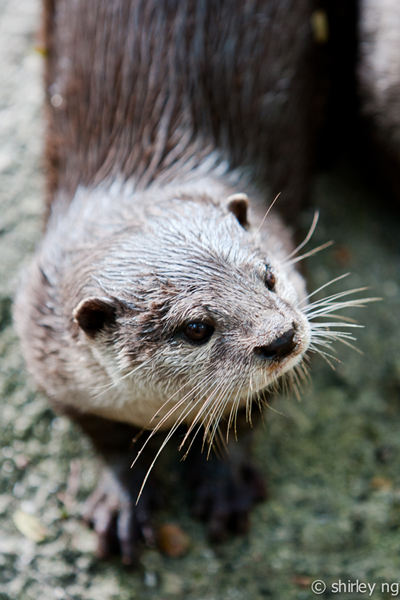Name
Binomial: Aonyx cinerea (Illiger, 1815)
Vernacular: Small-clawed otter
Other names: Asian small-clawed otter, Asian short-clawed otter, Oriental small-clawed otter
Etymology
The species epithet refers to the rudimentary claws of the species.
Taxonavigation
Class: Mammalia
Order: Carnivora
Table of Contents
Genus: Aonyx
Species: cinerea
Diagnosis
Two otter species occur in Singapore. They include the larger and more common smooth-coated otter Lutrogale perspicillata and this species which is cat-sized when fully grown. Below are several diagnostic features that set them apart from other Asian species.
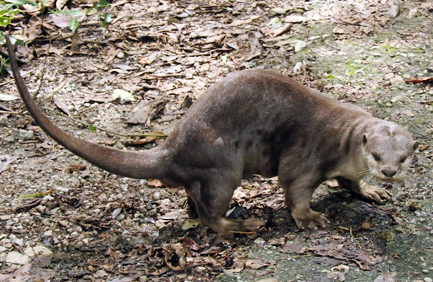 |
| Smooth-coated otter (Photo by: Meryl) |
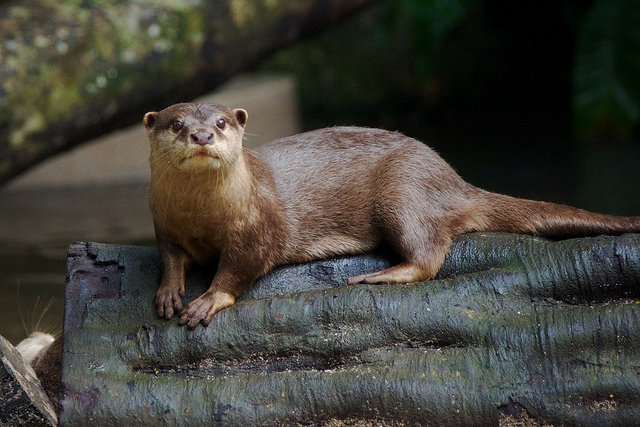 |
| Small-clawed otter (Photo by: Soon Tuck) |
From Sivasothi, 1995[1]
The small-clawed otter is the smallest species of otter with a body length of about 0.9m, which is only slightly more than half the size of a smooth-coated otter. Although there can be overlaps in size with the cubs of larger species of otters, a family group which consists entirely of small-sized otters is a telling sign that it is of this species.
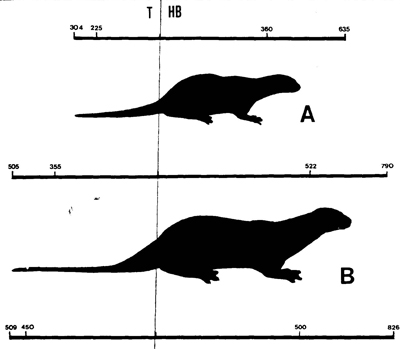 |
| Approximate relative size of Singapore species. A: Small-clawed otter; B: Smooth-coated otter. (from Sivasothi, 1995) |
Another diagnostic feature is their paws. As its common name suggests, the small-clawed otter has incompletely webbed feet which bear reduced claws that do not extend beyond the toes unlike the other Asian species.
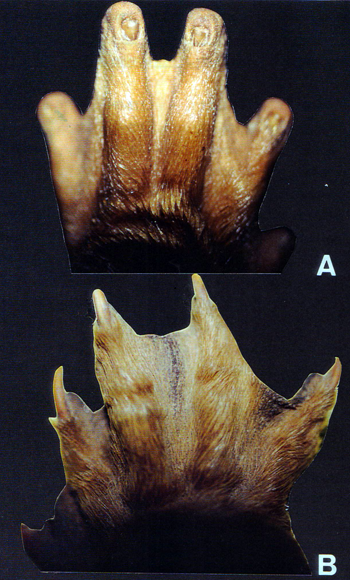
Forepaw of A: Small-clawed otter; B: Smooth-coated otter (ZRC Specimen: from Sivasothi,1995[1])
Their rhinaria is usually bare with a flat dorsal margin and anterior surface protruded forward, distinctly different from the other Asian species.
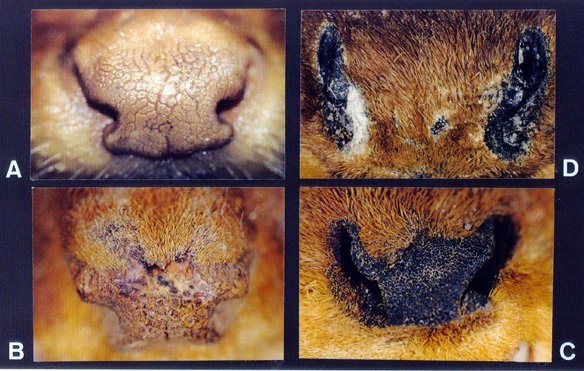
Rhinariums of Asian otters. A: Small-clawed otter; B: Smooth-coated otter; C: Eurasian otter; D: Hairy-nose otter (ZRC Specimen: from Sivasothi,1995[1])
Description

Schematic drawing of Aonyx cinerea, side view (from: Sivasothi & Nor, 1994[2]).
Size: Smallest otter species in the world of about 0.9m long and 5kg in weight.
Head & Body (HB) Length: 406-635mm; Tail length (T): 246-351mm; Total length: 652-939mm; weight usually 2.7-5.4kg. The females are on average only a little smaller than the males [1] [3] [4] [5].
Feet: Narrow, webbed only to last joint of toes; claws reduced, blunt
Tail: Tapered, not unusual
Rhinarium: Pink or dusky; bare; flat dorsal margin [1]
Colour: Generally very deep chocolate, almost blackish-brown, sometimes with a rufous tinge; paler below [3] [4], whitish to greyish.
Biology
Habitat
Small-clawed otters are found in a variety of habitats which include freshwater swamps, meandering rivers, mangroves and tidal pools [6] [7] [8]. Rice fields with substantial crab abundance can also sustain otter populations [8] [9].
Feeding habits
Consists mostly of crabs and molluscs, followed by significant proportions of amphibians and fish [8] [9] [10] [11].
Their dextrous and very sensitive hand-like front paws are used to feel for prey under boulders and logs, crevices, debris and vegetation both underwater and on the banks where their mostly invertebrate prey are hiding [12] [13] [14]. The dexterity of their paws can be appreciated in captivity, where juggling stones is common (see video).
Reproduction
From Lancaster, 1975[15]; Foster-Turley & Engfer, 1988[16]
Based on captive studies, small-clawed otters reach sexual maturity at 2 years. Breeding is not seasonal but based on an oestral cycle of 24-30 days, with a 3 day oestrus. Mating usually takes place in water. At the end of a 60-64 day gestation period, up to 6 pups are born.
This species form monogamous pairs and mate for life, with the female being dominant. Only the alpha pair of a group (the original parents) will breed.
Social organization
A gregarious species, they are often seen in groups that range from 2 individuals up to 15 [12] [17] [18] which communicate through spraint (otter faeces) and over 12 separate vocalizations [19].
More on the species biology here.
Distribution
From Hussainet al., 2008[20]
The small-clawed otter has a large distribution range, extending from India in South Asia east ward through entire Southeast Asia up to Palawan (Philippines), Taiwan and southern China in the north. In recent years, it has established itself in England after escaping from captivity [21] [22].
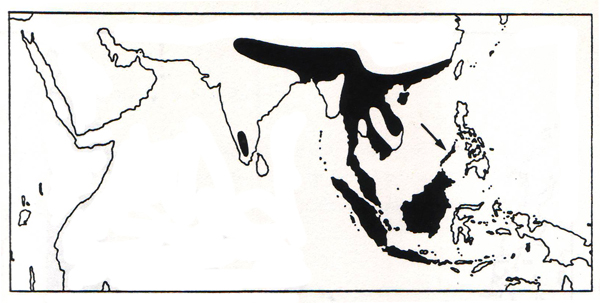
Distribution of the small-clawed otter (From Sivasothi, 1995)
Native to:
Bangladesh; Bhutan; Brunei Darussalam; Cambodia; China; India (Arunachal Pradesh, Assam, Himachal Pradesh, Karnataka, Kerala, Tamil Nadu, West Bengal); Indonesia; Lao People's Democratic Republic; Malaysia; Myanmar; Nepal; Philippines; Singapore; Taiwan, Province of China; Thailand; Vietnam
Threats
From Melisch et al., 1996[9] and Hussain et al., 2008[20]
Listed as 'Vulnerable' by IUCN and under Appendix II of CITES, the biggest threat to small-clawed otter populations is habitat destruction. Around Asia, wetland habitats are being reclaimed, dammed and converted to aquaculture among other things. The quality of existing habitats are reduced when waterways are canalized or dammed as bankside vegetation is reduced and high concrete walls are constructed, making it highly unfavourable for otter landings. Reduction of prey biomass and heavy metal contamination also contribute to the decline of otter populations.
Although protected by CITES, the small-clawed otter still faces the threat of being hunted for their pelt, killed as a pest and illegally traded in Indonesia where wildlife law enforcement is lacking.
Otters are fully protected under Singapore law[2]. However they are still at risk amid ongoing development. Reclamation work, damming and canalization of rivers, conversion of wetland habitats to urban areas, pollution and high coastal activity continue to threaten otter survival.
Status in Singapore
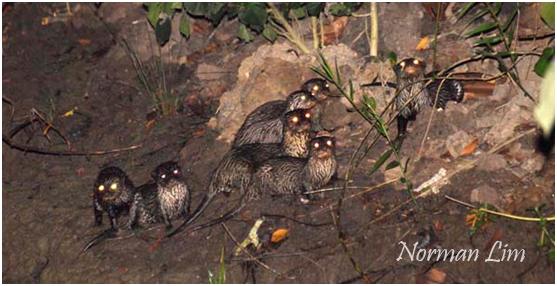 |
| Small-clawed otter sighting in Singapore (Photo by: Norman Lim) |
From Sivasothi & Nor, 1994[2]
Two species of otters, the small-clawed otter and smooth-coated otter Lutrogale perspicillata have been recorded in Singapore. Old records suggest that this was a common and abundant species in Singapore prior to the 1950s. However, from Harrison's (1966)[22] time, they appeared to be visitors rather than residents. In 1989, there was possibly a resident population in Pulau Tekong Besar (an island northeast of mainland).
From Sivasothi, 1994[24],
Based on several sightings between 1994 and 1995, it was concluded that a family group of at least one adult and four cubs was resident in Pulau Tekong Besar - the first recent records of resident small-clawed otters in Singapore.
From Vertebrate Study Group of the Nature Society (Singapore) and Raffles Museum of Biodiversity records,
Recent records (post-1998) of small-clawed otters are far and few between. The records were mostly between 2004 to 2006 and concentrated to the northeastern islands of Singapore (Pulau Tekong and Pulau Ubin).
Taxonomy
Being such a well-known species, it is surprising to find out that their taxonomy has always been problematical.
From Sivasothi, 1995[1]
Taxonomic problems mainly concern its generic status. According to Harris [4], the species was first described as Lutra cinerea by Illiger (1815). Subsequently, it was considered Amblonyx Rafinesque, 1832, a subgenus of Aonyx Lesson, 1827, followed by many mammal listings; though some use Amblonyx as a full genus. This classification was based on the assumption that rudimentary-clawed otters were closer related compared to the clawed ones. When Van Zyll de Jong[25] subjected quantitative and qualitative characters of extant species of otters to morphometric and cladistic analyses respectively, the results indicated that Amblonyx and Aonyx are divergent taxa.
During the rest of the 19th century, the species was renamed frequently, becoming amongst other things: Lutra leptonyx Horsfield, 1824; Thomas, 1889, Aonyx leptonyx Cantor, 1846, Aonyx horsfieldii Gray, 1837, Lutra barang Blyth, 1863, Micraonyx cinerea J. A. Allen, 1922; G. M. Allen, 1938. The specific epithet assignment of cinerea or cinereus was also a point of contention, where supporters of the latter argued that it should be accordance with the gender of the genus[25].
Eventually, the names Aonyx cinerea, Aonyx cinereus and Amblonyx cinereus were used.
From Koepfliet al., 2008[26]
A recent publication based on molecular taxonomy made it clear that this was the latest Asian otter species to arise and that surprisingly, was more closely related to the smooth-coated otter Lutrogale perspicillata rather than the African clawless otter Aonyx capensis.
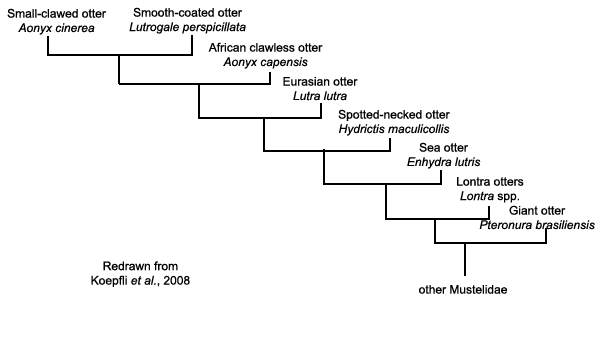 |
| Phylogeny of extant otter species |
Type information
The holotype and original description for any species is always crucial for its documentation. It is especially so for the case of Aonyx cinerea, which was initially known under many names until the realization that they all referred to the same species. The holotype for this species was designated long after the original descriptor, Illiger, 1815.
From Becking, 1989: 51[27]
The holotype is located in the Rijksmuseum van Natuurlijke Historie (National Museum of Natural History) in Leiden, The Netherlands under the epithet “Amblonyx cinerea wurmbi Sody, 1933”.
Additional holotype information,
Holotype: RMNH 33855 (coll. Sody No. Bras III No. 1), adult female
Type Locality: Indonesia, E. Java, Besuki, Watangan Mts, near Puger, 50m.
Collected by J. H. F. Bras, 8 November 1929
Annals and Magazine of Natural History, London, Ser. 10, 12:411.
Literature and References
- Sivasothi, N., 1995. A review of otters (Carnivora: Mustelidae: Lutrinae) in Singapore and Malaysia, and the diet of the Smooth Otter (Lutrogale perspicillata) in Penang, West Malaysia. Unpublished MSc thesis, National University of Singapore.
- Sivasothi, N. & B. H. M. Nor, 1994. A review of otters (Carnivora: Mustelidae: Lutrinae) in Malaysia and Singapore. Hydrobiologia, 285: 151-170.
- Pocock, R. I., 1941. The fauna of British India including Ceylon and Burma, Mammilia II. London: Taylor & Francis. Pp 265-317.
- Harris, C. J., 1968. Otters: A Study of the Recent Lutrinae. Weidenfeld & Nicolson, Lond., 397 pp.
- CITES, 1983. CITES otter identification sheets. (Appendix 1). In Foster- Turley et al., op. cit.: 90-113.
- Osman, B. & S. Shariff, 1988. A preliminary survey on the status and distribution of otters in Peninsular Malaysia. IUCN/SSC Asian Otter Specialist Group Newsletter, 1: 11.
- Nor, B. H. M., 1989. Preliminary study on food preference of Lutra perspicillata and Aonyx cinerea in Tanjung Piandang, Perak. J. Wildl. Natl Parks, 8: 47-51.
- Foster-Turly, P. 1992. Conservation as aspects if the ecology of Asian small-clawed and smooth otters on the Malay Peninsula. IUCN Otter Specialist Group Bulletin, 7: 26-29.
- Melisch, R., L. Kusumawardhami, P. B. Asmoro & I. R. Lubis, 1996. The otters of West Java: A survey of their distribution and habitat use and a strategy towards a species conservation programme. PHPA/Wetlands International – Indonesia Programme, Bogor.
- Lekagul, B. & J. A. McNeely, 1988. Mammals of Thailand. Second edition. Darnsutha Press, Thailand, 758 pp.
- Kruuk, H., B. Kanchanasaka, S. O’Sullivan & S. Wanghongsa, 1994. Niche separation in three sympatric otters Lutra perspicillata, L. lutra and Aonyx cinerea in Huai Kha Khaeng, Thailand. Biological Conservation, 69: 115-120.
- Wayre, P., 1976. The River People. Souvenir Press, Lond., 187 pp.
- Foster-Turley, P., 1991. The status of otters in Asia. In: Reuther, C.: Rochert, R. (eds.), Proceedings of the Vith International Otter Colloqium, Hanskensbuttel. Habitat, 6: 21-25.
- Kruuk, H., 2006.Otters: ecology, behaviour and conservation. Oxford Biology, 256pp.
- Lancaster, W. E., 1975. Exhibiting and breeding the Asian small-clawed otter, Amblonyx cinerea, at the Adelaide Zoo. International Zoo Yearbook, 15: 63-65.
- Foster-Turley, P. & S. Engfer, 1988. The species survival plan for the Asian small-clawed otter Aonyx cinerea. International Zoo Yearbook, 27: 79-84.
- Furuyu,Y., 1977. Otters in Padas Bay, Sabah, Malaysia. J. Mammal. Soc. Jpn., 7: 39-43.
- Mason, C. F. & S. M. Macdonald, 1986. Otters – ecology and conservation. Cambridge: Cambridge University Press, Cambridge, 236pp.
- Timmis, W. H. 1971. Observations on breeding the oriental short-clawed otter Amblonyx cinerea at Chester Zoo. International Zoo Yearbook, 11:109–111.
- Hussain, S.A., P.K. de Silva. & M. M. Feeroz , 2008. Lutrogale perspicillata. IUCN Red List of Threatened Species, Version 2010.3. http://www.iucnredlist.org/apps/redlist/details/12427/0/. Accessed on 11 November 2011.
- Jefferies D. J., 1990. The Asian short-clawed otter Amblonyx cinerea (Illiger) living wild in Britain. J Otter Trust, 2(3): 21-25
- Jefferies D. J., 1991. Another record of an Asian short-clawed otter living free in the Oxford area of England, with notes on its implication. J Otter Trust, 2(5): 9-12.
- Harrison, J. L., 1966. An Introduction to the Mammals of Singapore and Malaya. The Singapore Branch, Malayan Nature Society, Singapore, 340 pp.
- Sivasothi, 1994. A family group of the small-clawed otter, Amblonyx cinereus (Illiger, 1815) (Carnivora: Mustelidae: Lutrinae, on Pulau Tekong Besar, the second resident wild carnivore in Singapore. The Pangolin, 7: 23-31.
- Van Zyll de Jong, C. G., 1987. A phylogenetic study of the Lutrinae (Carnivora: Mustelidae) using morphological data. Can. J. Zool., 65: 2536-2544.
- Koepfli, K-P., B. Kanchanasaka, H. Sasaki, H. Jacques, K. D. Y. Louie, T. Hoai, N. X. Dang, E. Geffen, A. Gutleb, S. Han, T. M. Heggberget, L. LaFontaine, H. Lee, R. Melisch, J. Ruiz-Olmo, M. Santos-Reis, V. E. Sidorovich, M. Stubbe & R. K. Wayne, 2008. Establishing the foundation for applied molecular taxonomy of otters in Southeast Asia. Conserv. Genet., 9: 1589-1604.
- Becking, J. H., 1989. Henri Jacob Victor Sody (1829-1959): his life and work: a biographical and bibliographical study. Brill Archive, 272 pp.
Links to other types of species pages
http://www.otterspecialistgroup.org/Species/Aonyx_cinereus.htmlhttp://data.iucn.org/dbtw-wpd/html/Otter/Appendix%201f61.html
| Subject | Author | Replies | Views | Last Message |
|---|---|---|---|---|
| No Comments | ||||
